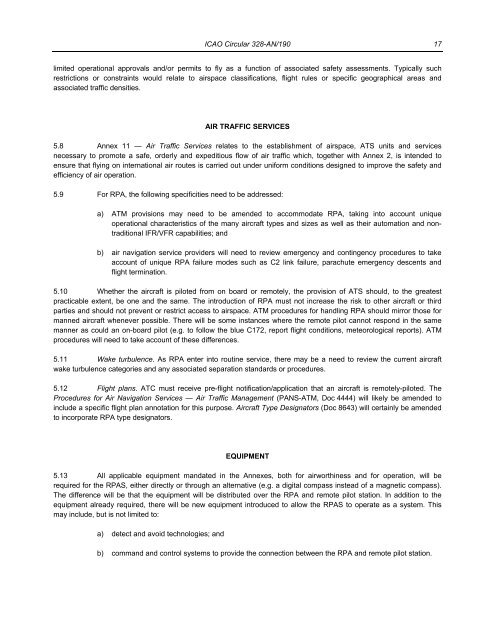Circular 328_en
Circular 328_en
Circular 328_en
You also want an ePaper? Increase the reach of your titles
YUMPU automatically turns print PDFs into web optimized ePapers that Google loves.
ICAO <strong>Circular</strong> <strong>328</strong>-AN/190 17<br />
limited operational approvals and/or permits to fly as a function of associated safety assessm<strong>en</strong>ts. Typically such<br />
restrictions or constraints would relate to airspace classifications, flight rules or specific geographical areas and<br />
associated traffic d<strong>en</strong>sities.<br />
AIR TRAFFIC SERVICES<br />
5.8 Annex 11 — Air Traffic Services relates to the establishm<strong>en</strong>t of airspace, ATS units and services<br />
necessary to promote a safe, orderly and expeditious flow of air traffic which, together with Annex 2, is int<strong>en</strong>ded to<br />
<strong>en</strong>sure that flying on international air routes is carried out under uniform conditions designed to improve the safety and<br />
effici<strong>en</strong>cy of air operation.<br />
5.9 For RPA, the following specificities need to be addressed:<br />
a) ATM provisions may need to be am<strong>en</strong>ded to accommodate RPA, taking into account unique<br />
operational characteristics of the many aircraft types and sizes as well as their automation and nontraditional<br />
IFR/VFR capabilities; and<br />
b) air navigation service providers will need to review emerg<strong>en</strong>cy and conting<strong>en</strong>cy procedures to take<br />
account of unique RPA failure modes such as C2 link failure, parachute emerg<strong>en</strong>cy desc<strong>en</strong>ts and<br />
flight termination.<br />
5.10 Whether the aircraft is piloted from on board or remotely, the provision of ATS should, to the greatest<br />
practicable ext<strong>en</strong>t, be one and the same. The introduction of RPA must not increase the risk to other aircraft or third<br />
parties and should not prev<strong>en</strong>t or restrict access to airspace. ATM procedures for handling RPA should mirror those for<br />
manned aircraft wh<strong>en</strong>ever possible. There will be some instances where the remote pilot cannot respond in the same<br />
manner as could an on-board pilot (e.g. to follow the blue C172, report flight conditions, meteorological reports). ATM<br />
procedures will need to take account of these differ<strong>en</strong>ces.<br />
5.11 Wake turbul<strong>en</strong>ce. As RPA <strong>en</strong>ter into routine service, there may be a need to review the curr<strong>en</strong>t aircraft<br />
wake turbul<strong>en</strong>ce categories and any associated separation standards or procedures.<br />
5.12 Flight plans. ATC must receive pre-flight notification/application that an aircraft is remotely-piloted. The<br />
Procedures for Air Navigation Services — Air Traffic Managem<strong>en</strong>t (PANS-ATM, Doc 4444) will likely be am<strong>en</strong>ded to<br />
include a specific flight plan annotation for this purpose. Aircraft Type Designators (Doc 8643) will certainly be am<strong>en</strong>ded<br />
to incorporate RPA type designators.<br />
EQUIPMENT<br />
5.13 All applicable equipm<strong>en</strong>t mandated in the Annexes, both for airworthiness and for operation, will be<br />
required for the RPAS, either directly or through an alternative (e.g. a digital compass instead of a magnetic compass).<br />
The differ<strong>en</strong>ce will be that the equipm<strong>en</strong>t will be distributed over the RPA and remote pilot station. In addition to the<br />
equipm<strong>en</strong>t already required, there will be new equipm<strong>en</strong>t introduced to allow the RPAS to operate as a system. This<br />
may include, but is not limited to:<br />
a) detect and avoid technologies; and<br />
b) command and control systems to provide the connection betwe<strong>en</strong> the RPA and remote pilot station.


